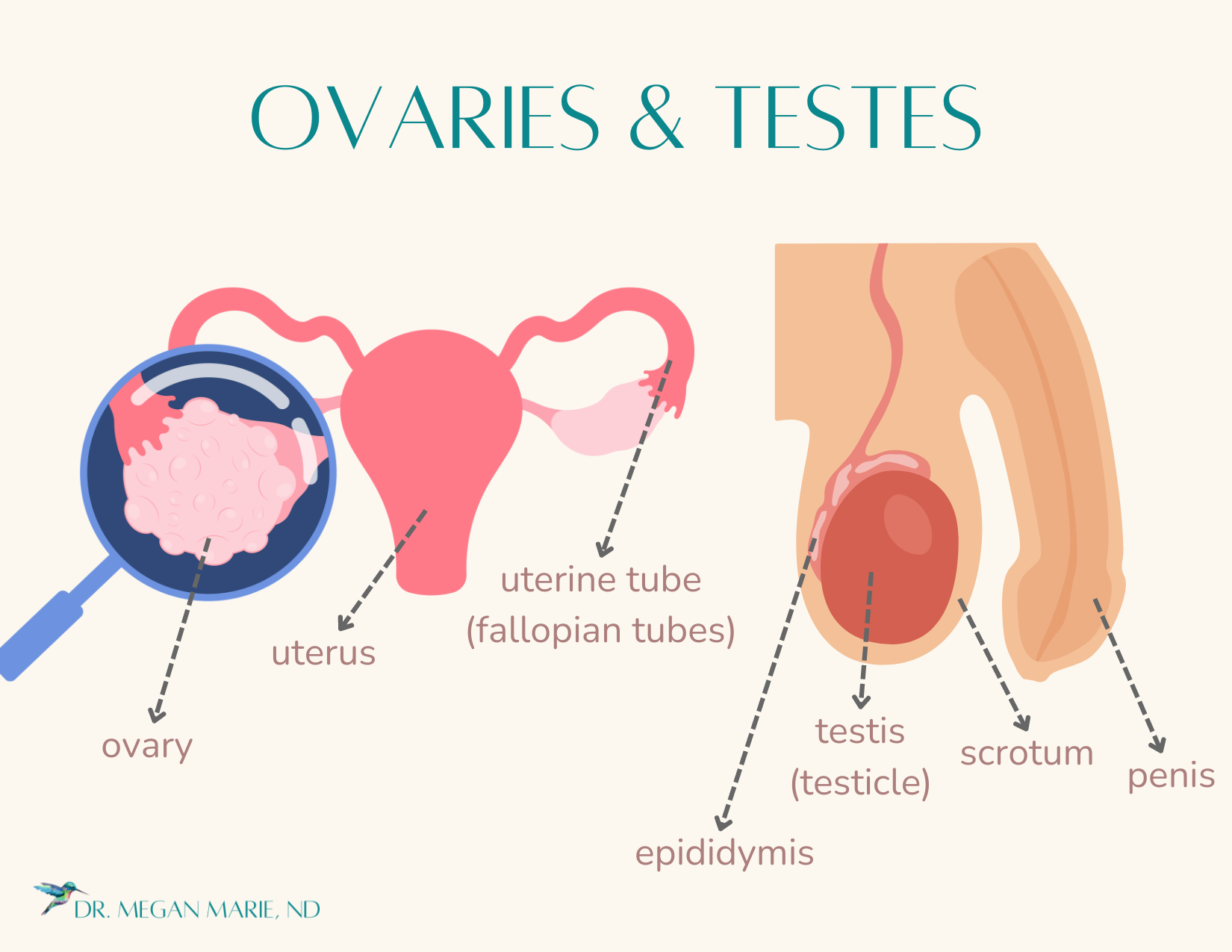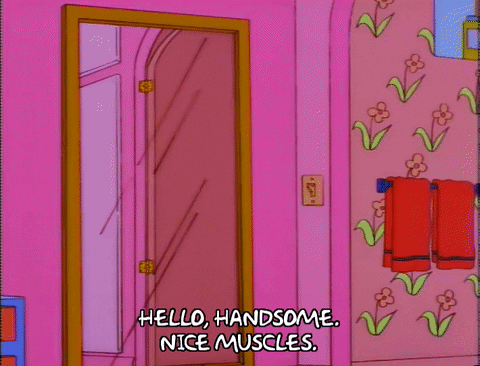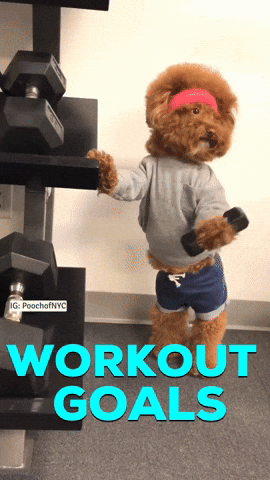Gonads: The Structure Makers (Part 1)
Inclusivity: My intention is for this article to be inclusive of all people who want to learn more about how hormones support their bodies. While I use the words men and women or male and female, as you read, please insert the words that you relate to. I appreciate your patience and curiosity despite any language shortcomings.
The female gonads are the ovaries, paired glands on either side of the uterus. And the testes, or testicles, are the male glands, located behind the penis within the scrotum. Yes, they are both key for sexual and gender development, but these hormones also impact every other system in the body. Because they do so much, I’m splitting this post into two parts.
Estrogen, progesterone and testosterone are all produced in all of us, though in differing concentrations depending on your chromosomes.
Obviously, the reproductive cycle is significant, but if you’re here, you’ve probably read about that a few times already. I will do a separate post specifically on the male and female reproductive cycle, but today, I want to explain why “hormonal balance” is important beyond sexual and reproductive health. I want people to start seeing these “sex” hormones as being just as significant as insulin or thyroid, not just as being responsible for moods or physical traits.
We’re going to go through each of the body systems, and briefly describe how progesterone, estrogen, and testosterone impacts them.
TYPES OF HORMONES
ESTROGEN
Unless otherwise stated, when I use the word estrogen I’m referring to estradiol.
There are three types of estrogen:
estriol - primarily present during pregnancy, and weaker than estradiol
estradiol - the dominant estrogen in premenopausal women (most of a woman’s life)
estrone - dominant in postmenopausal women, and less metabolically active
TESTOSTERONE
When I use the word testosterone I’m referring to active, free testosterone. Dihydrotestosterone (DHT) is a more potent androgen (male hormone) derived from testosterone which can affect hair, skin, and the prostate more than metabolism or muscle. DHT is typically responsible for male balding.
PROGESTERONE
Progesterone is the main bioactive hormone. For this post there’s no need to distinguish between different forms. But be aware that there are differences between natural progesterone and synthetic progestins like those in contraceptives. They have different impacts on the body, particularly in HRT (hormone replacement therapy) or contraceptive use. Progesterone and progestin are not interchangeable.
MUSCULOSKELETAL SYSTEM
BONE HEALTH & DENSITY
Testosterone builds, estrogen remodels, progesterone supports.
ESTROGEN – helps to regulate the activity of osteoclasts (a type of cell that is responsible for breaking down/remodeling bone), meaning it helps regulate (inhibits) the rate of bone breakdown, allowing for a balance between bone formation and resorption. This is especially relevant to women’s health, because in menopause, estrogen levels decline. Without estrogen there to pump the breaks, women can be prone to osteoporosis (weak, brittle bones). This is why postmenopausal women are at a higher risk for fractures and bone loss, and why calcium and vitamin D supplementation are so strongly recommended in this population.
TESTOSTERONE – in contrast, testosterone promotes osteoblasts (cells that are responsible for building new bone). This is partially why men tend to have stronger bones than women. As men go through andropause (the male equivalent of menopause) this may impact their bone health as well.
PROGESTERONE – its role is still unclear; however, it may stimulate bone formation by supporting osteoblast activity.
MUSCLE MASS & STRENGTH
Testosterone builds, estrogen heals, progesterone remodels.
TESTOSTERONE – increases muscle protein synthesis, meaning greater muscle mass, strength, and endurance. This is why men have, and can build more, muscle than women. Testosterone declines in all of us as we age, leading to a natural loss of muscle mass and strength. This is why strength training and movement are so important, to counterbalance muscle loss.
ESTROGEN – supports muscle health and integrity. It has anti-inflammatory effects; it helps protect muscles from damage and supports the healing process in all of us.
PROGESTERONE – in excess, can actually cause muscle breakdown. This can be why during pregnancy or the luteal phase of a menstrual cycle , many women may feel more fatigue, with reduced exercise capacity.
JOINTS & FLEXIBILITY
Testosterone stabilizes, estrogen balances, progesterone increases flexibility.
TESTOSTERONE – indirectly testosterone helps our joints, tendons, and ligament through its promotion of muscle mass and bone density. Increased muscle mass stabilizes the joints and takes strain off the tendons and ligaments during physical activity, helping reduce risk of injury.
ESTROGEN – maintains joint health by helping to keep your cartilage, ligaments, and tendons healthy. It balances collagen, which is critical for joint cushioning and flexibility.
PROGESTERONE – increases flexibility, but also reduces joint stability. It’s anti-inflammatory, helping to reduce joint pain.
Postmenopausal women may experience more joint pain and stiffness as a result of decreased estrogen and progesterone. Likewise, hormonal fluctuations during the menstrual cycle, may also predispose women to tendon injuries.
Weightlifting or strength training & high-intensity interval training (HIIT) may help increase testosterone, while endurance training (long-distance running or cycling) may lower it. Strength training and moderate intensity cardio may help maintain balanced estrogen & progesterone levels, while excessive high-intensity exercise may trigger cortisol production and suppress progesterone.
CARDIOVASCULAR SYSTEM
There’s actually quite a bit of role overlap in this system. So rather than breaking down what each does, I’ll list what they all support instead.
VASODILATION - they either enhance nitric oxide production or otherwise relax the blood vessels, improving blood flow and reducing vascular resistance (strain on the heart).
LIPID REGULATION - they all help to raise HDL (“good” cholesterol), lower LDL (“bad” cholesterol) and lower triglycerides (fat) preventing buildup in the blood (reducing plaque and inflammation). They support liver function by regulating liver enzymes that manage cholesterol synthesis and breakdown.
ANTI-INFLAMMATORY - they all help to reduce inflammation, reducing the risk of atherosclerosis (hardened arteries).
BLOOD PRESSURE - by promoting vasodilation and healthy circulation; progesterone acts to reduce sodium (it’s a natural diuretic).
HEART RHYTHM - they all help to reduce arrhythmias (irregular heart beats); progesterone regulates calcium (heart muscle contraction) and potassium (return to resting) in heart cells.
As our hormones decline with age, we are at an increased risk of heart disease due to higher cholesterol, inflammation, and blood pressure changes. This is why moving daily and eating real foods can be such a worthwhile investment in your health.
As you can see, our gonadal hormones—testosterone, estrogen, and progesterone—are about far more than sexual development. They play vital roles in maintaining our bones, muscles, joints, and cardiovascular system. Knowing how much they do, helps us feel connected to our every day nutritional, movement, and lifestyle choices—knowledge is empowerment.
Next week, we’ll dive deeper into how these same hormones impact the nervous, immune, and digestive systems. Understanding this holistic picture is key to realizing that "hormonal balance" affects so much more than just mood or physical traits. Stay tuned for Part 2!
PITUITARY GLAND: THE REGULATOR
THYROID GLAND: THE METABOLISM MANAGER
ADRENAL GLANDS: THE STRESS RESPONDER
PANCREAS (REVISITED): THE SUGAR REGULATOR
GONADS: THE STRUCTURE MAKERS
PINEAL GLAND: THE SLEEPER & HEALER





